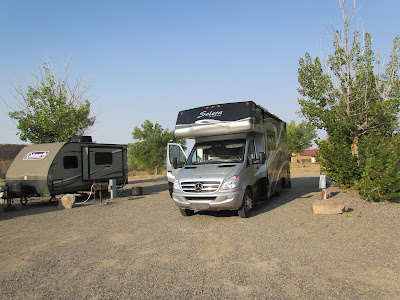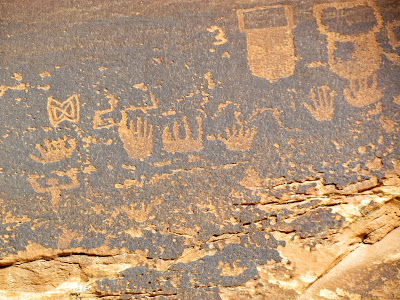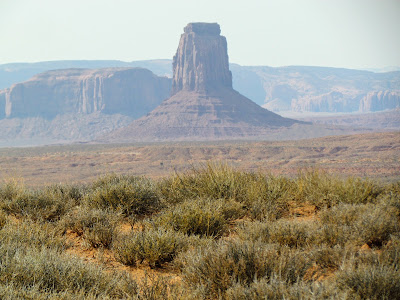2020-27
Bluff Utah
Monument Valley,
Utah
Page Arizona (two
days)
Kanab Utah (second
time this summer)
Pipe Springs (20
miles down the road)
Campground: Bluff Utah. Cadillac Ranch Rv pk. Pay online, $25 +$3.40 taxes, full hookups, 30/50 amp. Basic pull-thru sites. One night, just passing through. it’s hot or I would have gotten a free campsite in the area.
Campground: Gouldings Campground/Resort. $66.55 full hookups cable tv, swimming pool, restaurant, gift shop, museum of Hollywood movies locations, on sight . One night. Price is expected to go up the first of the year. Excellent location when visiting the Monument Valley area.
Campground: Page Az. McDonald’s. Large side parking lot, pull-thru sites for campers, trailers. Free
no pics
Campground: Lone Rock, Lake Powell. $7 senior rate. Dispersed camping, dump station and potable water available.
 |
| view from my campsite, upper level |
Campground: Crocodile ATV Trail parking, Johnson Canyon Road. Free
no pics, dirt parking lot, nice views
Campground: Passport America, half off, Kaibab Paiute RV campground. $12.50 full hookups, 30/50 amp service. Nice covered patio for guests to meet up. Laundry and Rec hall. Very good WIFI.
 |
| view from group shelter/picnic tables I would highly recommend this place |
Bluff Utah.
 |
| Bluff, fort museum, Mormon history developing the area |
What an interesting small western town USA. A visit to the Bluff Fort Historic site will tell you all about this town of 320 folks. Having gotten it’s start back in 1880 when the Church of Jesus
 |
| Joseph Barton Original Family Cabin |
Christ of Latter-day Saints (Mormons) sent pioneers to develop this bit of land in the SE corner of the state. It sat between two native Indian tribes, the Ute’s and the Navajo tribes. Hoping to forge better relations with the Indians.
It would be the roughest route any wagon train ever took, averaging only 1.7 miles per day along the 250 miles. Including the Hole-in-the-wall which was a vertical decent from 4329 ft down to 1800 ft. With slopes as steep as 45 degrees to 25 degrees. 258 members, including children, 83 wagons, 200 draft animals and 1800 loose stock.
They built the log homes with fort walls between for protection. But after being settling in for a short time, they had made friends with the Indians and eventually removed the fort walls. Having many Indians join them for dinner and trading.
What determination, much of it based on religious zeal I’m sure. Good to get to know the history of these western towns. So many having been started due to mining, forestry etc. The Mormons are a big influence out here not only in Utah, but many of the bordering states.
Sand Island Petroglyph Panels.
Just on the edge of town is Sand Island, BLM land. They have a great campground, no hookups next to the San Juan River and the Sand Island Petroglyph Panels. Depending on the time of year, this is a great campground. Cottonwood trees provide shade as well.
 |
| one of the newest petroglyphs as horses were first introduced with the landing of the first Europeans |
Monument Valley
 |
| Classic view of Monument Valley I have to stop every time, take pictures and absorb the spectacular scene |
51 miles on down the road, passing through Mexican Hat, I had to stop at the most iconic road in the old west. This shot is where many movies and commercials are filmed. The Navajo Indians own the land and unfortunately they are not giving tours at this time due to Covid 19. But you can’t lock up the scenery and I’ve decided to stay at Gouldings Trading Post/campground for the night. Just to stay in the area a bit longer. The campground is charging $66.55 per night full hookups and I would usually not pay that pricey amount. But the area is so spectacular, I had to cave in and pay the price. There are very few camping opportunities in this area and electric is required with the excessive heat throughout the summer months. And I’m told the price will go up after the first of the year.
 |
| Mexican Hat |
After an extremely slow server came with my lunch, I finally got to the campsite, relaxed a bit and took a walk along a cool path as it clung tot he edge of a red sandstone cliff. Along the way were peekaboo views of Monument Valley as Gouldings is tucked into a massive red rock canyon. A bit further and a natural arch comes into view. Unexpected and stunning, though the trail name should have given me a clue. I’m often clueless and the surprises I come across are always appreciated.
 |
| Morning hike along trail just above the campground |
 |
| views thru canyon into Monument Valley |
 |
| sage |
 |
| the trail to the Arch |
 |
| peak through to Monument Valley |
Heading on out the next day, surprised at the temperatures being very reasonable for this time of year. I’m heading back into Arizona, then back to Utah to Page Az and the Lake Powell area where I’ll pick up my mail. A night in-town, then out to Lone Rock (BLM $7.00) for some spectacular views of the very low Lake Powell and Lone Rock. I would have liked to camp on the beach, but darn if it wasn’t more crowded than a 10 block city highway.
After picking up my mail, I’m off to join a couple of friends, Matt and Madonna. We’ll take our bikes out for a ride along the reservoir paved trail and a whole new extension that was completed over the summer months.
Pipe Springs, AZ
 |
| Mormons built a fort right over the springs controlling it's use... |
I’ve headed on down the road after a couple of days visit, 20 miles, to Pipe Springs, surrounded by the Kaibab Paiute Indian Reservation.
Pipe Springs is a complex mix of history, overlapping the lives of Paiute, Ute, Navajo Indians, with Mormon explorers moving into the area. The history starts back in the Ancestral Puebloans, gradually exiting the area around 1,000-1,250. The Paiutes moved in, being well suited tot he harsh environment. Moving seasonally to hunt up on the Kaibab forests before descending to the Pipe Springs area for the winter months. By the 1500’s European diseases devastated all of the Native Indian tribes. As if that wasn’t enough, the Ute and Navajo tribes raided the Kaibab Paiute’s taking those captured into a life of slavery, reducing the Paiute tribe to around 1,200. Well, you’d think that would be enough, but no, the Missionaries, in this case those of the Mormon faith moved into the area, 1860’s, obtaining a title to 160 acres around Pipe Springs. With the land title, James Whitmore moved in tons of sheep and cattle and built around the springs, blocking access to the Indians. The more aggressive Navajo raided the livestock and killed Whitmore and his herdsman. By 1868 Mormon Militiamen built a stone cabin, and eventually a fort right over the springs. All those cattle and sheep had decimated the long prairie grass the was a sustaining factor in the Paiute Indians way of life. Along with the loss of water. Their lives were in shambles. Today, a water agreement has been made splitting the water rights equally between the Grand Canyon National Park, ranchers, and the Paiute reservation. The reservation, where I am staying at their campground consists of 120,000 acres. The Southern Paiute Nation currently consists of 250 members.
more photos:
Page AZ (Lone Rock) Kanab Utah







































No comments:
Post a Comment
your comments are always appreciated. After submitting a comment, it will not show up right away, as the moderator must approve all comments.